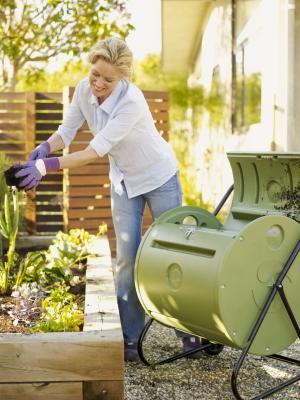Composting turns certain waste products into a nutrient-rich material that you can then use in your garden. Large compost piles in the backyard might come to mind, but you can compost even if you have no outdoor space for a compost bin. No matter what the scale of your compost method, your efforts reduce the amount of waste sent to the landfill.
Compost Pile
An outdoor compost pile is a basic composting option that doesn’t require any special units or materials. The University of Illinois Extension recommends a heap at least 5 feet wide by 3 feet deep for the fastest composting. This particular size allows the heap to generate enough heat to break down the materials. Stirring the heap speeds up the decomposition process, but it is not required. You should stir the pile when food scraps are added to avoid pests.
You can also build your own structure around the heap to keep it contained. Many different materials work to build a compost structure, including concrete blocks, bricks, landscape timbers, pallets and barrels.
Enclosed Composter
Enclosed composters or holding units keep all the composted materials contained. This process is slower than an open heap or pile because it receives less oxygen. Depending on the design of the unit, you might be able to turn the contents periodically to add oxygen for faster composting. Because new materials are added to the top of the holding unit, the finished compost is usually at the bottom. When choosing this method, look for a unit that allows you to access the compost at the bottom. Barrel composters are enclosed units designed for occasional turning. This allows you to add oxygen to the process for faster compost.
Kitchen Composting
For those with limited outdoor space, a kitchen composting unit is a possibility. The unit itself is small, usually about the size of a 5-gallon bucket. You can keep it under your sink or in a corner of the kitchen, depending on available space. Because of the small size, you might not be able to compost all your food scraps.
Vermicomposting
Vermicomposting uses worms to help break down the materials at a faster rate. The worm castings also add nutrients to the compost. Red wiggler earthworms are commonly uses for vermicomposting. The process works either indoors or outdoors, depending on your personal preference. You can construct a bin or use an old barrel or other container. A maximum depth of 8 to 12 inches is best, according to New Mexico State University Cooperative Extension Service.





